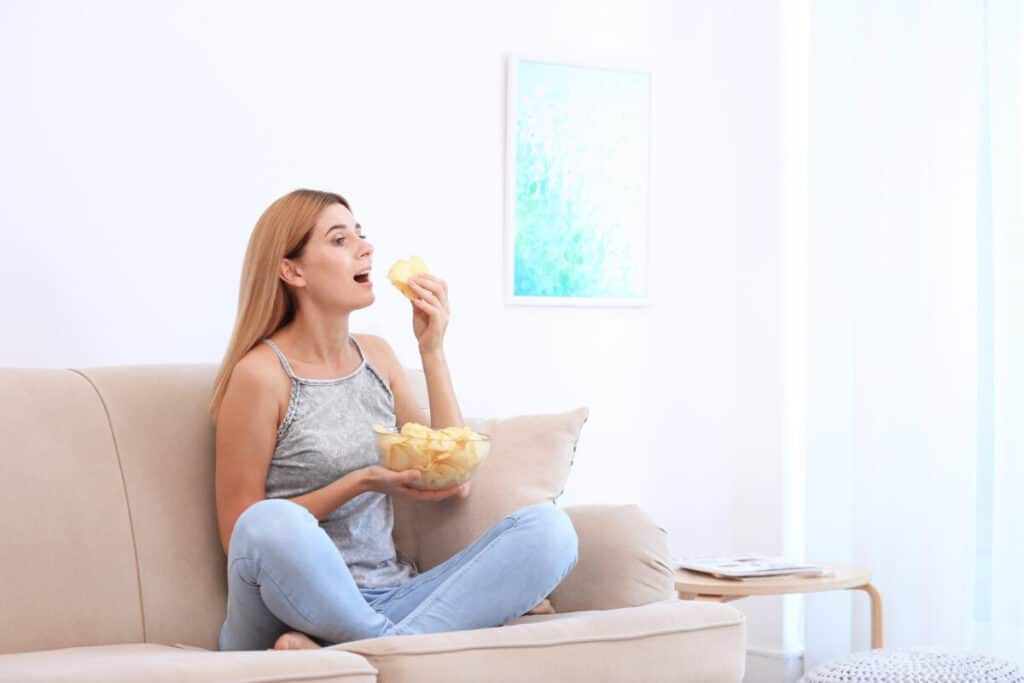
Some people have a sweet tooth, but for many of us, salty snacks are the go-to comfort food of choice. Potato chips, Dorito’s, Tostito’s Cheeto’s, Frito’s, Muncho’s, and all the others ending in an “o,” or other letters—they beckon temptingly when you’re hungry.
But you’d be hard-pressed to find a greater concentration of empty calories, unhealthy fat and excessive salt than potato chips and similar salty snacks. They’re addictive; the manufacturers even brag about it. Remember Pringles’ ad slogan, “Once you pop, you can’t stop?” And Lay’s was “Bet you can’t eat just one.”
Here are ways to stop eating potato chips. Then keep reading for replacement ideas; a nutrition comparison of the top chip brands; and information on why chips aren’t good for you.
9 Tips on How to Give up the Chips
- Start by cleaning out your pantry—Remove temptation. Throw all the chips in your house away. If others in your household insist on buying chips, ask them to hide them from you.
- Don’t by them again—When you go to the store, don’t cruise the snack aisle. Put your blinders on and roll right past it. Nothing to see there, folks. Allow yourself to buy items only on your shopping list—and don’t put chips on your list.
- Visualize the consequences for your body—Before you put a chip in your mouth, contemplate what it will do in your body and to your cells. Envision the unhealthy fats damaging your DNA; the salt increasing your blood pressure; and the carbs spiking your insulin. Imagine the empty calories converting to fat in your belly and staying there for years.
- Stop adding salt to your food throughout the day—This will help restore your sensitivity to salt, and make the salt in chips seem excessive and distasteful.
- Eat satisfying meals throughout the day—This will help you get rid of cravings for snacks. Include protein and a healthy fat (like avocado, nuts, seeds or olive oil) with every meal.
- Bring your own snacks with you wherever you go—Even if you buy lunch out, at work or when running errands, bring your own healthy, savory side dish/snack (see ideas below).
- Eat more of the main dish—If you eat chips with meals because the rest of the meal isn’t filling enough, eat more of the main meal. For example, I used to order a 6″ Subway veggie sandwich and chips; now I order a 12″ sandwich and no chips. I get a similar amount of calories as the chips, but in filling, wholesome food instead of junk food.
- Identify when and why you eat chips—What are you feeling when you reach for unhealthy chips? Write it down and track it. Get clear on these root causes and make a plan to address them.
- Do you always eat them at lunch, reflexively?
- Do you snack on them when your blood sugar plummets, because you didn’t eat enough protein at your last meal?
- Are you stress eating?
- Do you eat them when you drink alcohol? Drinking triggers carb cravings, studies show (reference)
- Replace chips with something else—One theory of habit change is to replace the bad habit with something else. Read on.
9 Ideas for Replacing Potato Chips or Other Salty Snacks
All these options for replacing potato chips in a meal or as a snack are savory, a little salty, and generally good for you:
- Popcorn—High in fiber and low in calories (if you don’t add a lot of oil or butter). Enjoy it three ways:
- Pop your own kernels, and season with pepper or nutritional yeast for a parmesan-like flavor and added B vitamins.
- Buy a pre-popped brand not made with unhealthy fats.I like Skinny Pop original. You can buy a case of their individual serving size bags at a reasonable price here on amazon.
- A great microwave brand is Quinn; its biodegradable bags have no chemical coatings or plastics, and the popcorn is organic and non-GMO. You can check it out here on amazon.
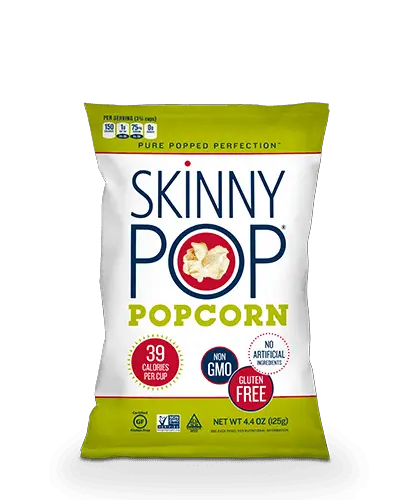
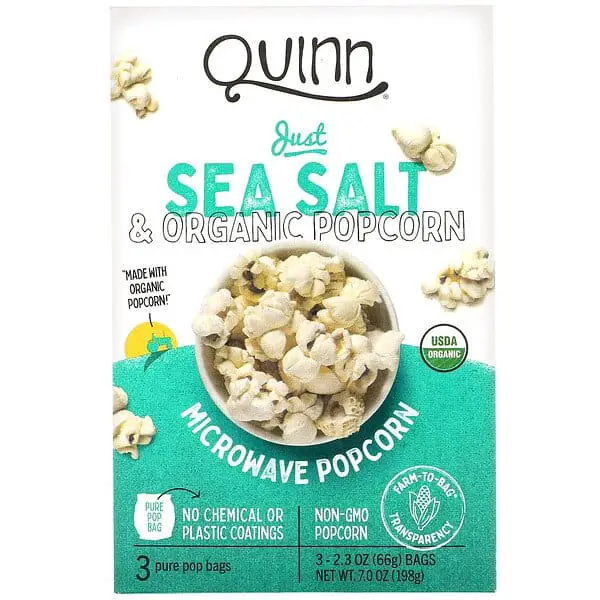
- Nuts—Any type will do. Many brands are fried in oil (that’s what dry roasting means in the nut industry, which is pretty nutty). The best choices are raw or toasted without added oil.
- Fisher brands are never fried in oil; buy them here on amazon.
- Pistachios in the shell are a great option because they take work to eat; the shells slow you down.
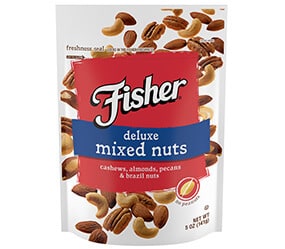
- Kale chips – make your own, it’s super easy; here is a good recipe from Allrecipe. You can use the same technique with carrots, beets, turnips and other veggies. Here is an amazing recipe for Smoked Paprika Zucchini Chips from Nutrition Sisters.
- Edamame—soy beans in the pod make you work a bit for them. You can buy them frozen—already cleaned, prepped and ready to cook.
- Roasted pumpkin or sunflower seeds—many grocery and health food stores offer these in bins or pre-packaged. They will have been roased in oil, but are more healthy than potato chips.
- Roasted chickpeas—The upside is that these are mainly whole chickpeas; not flour. But the store-bought variety are roasted in oil, and sometimes include a lot of salt or other flavorings. Still, the chickpeas pack a protein punch and offers additional nutrients you wont find in potato chips. Try the Biena brand here on amazon. I find this snack to be a bit on the dry side, but it’s filling. Or try making your own; here is a great recipe from Love and Lemons.
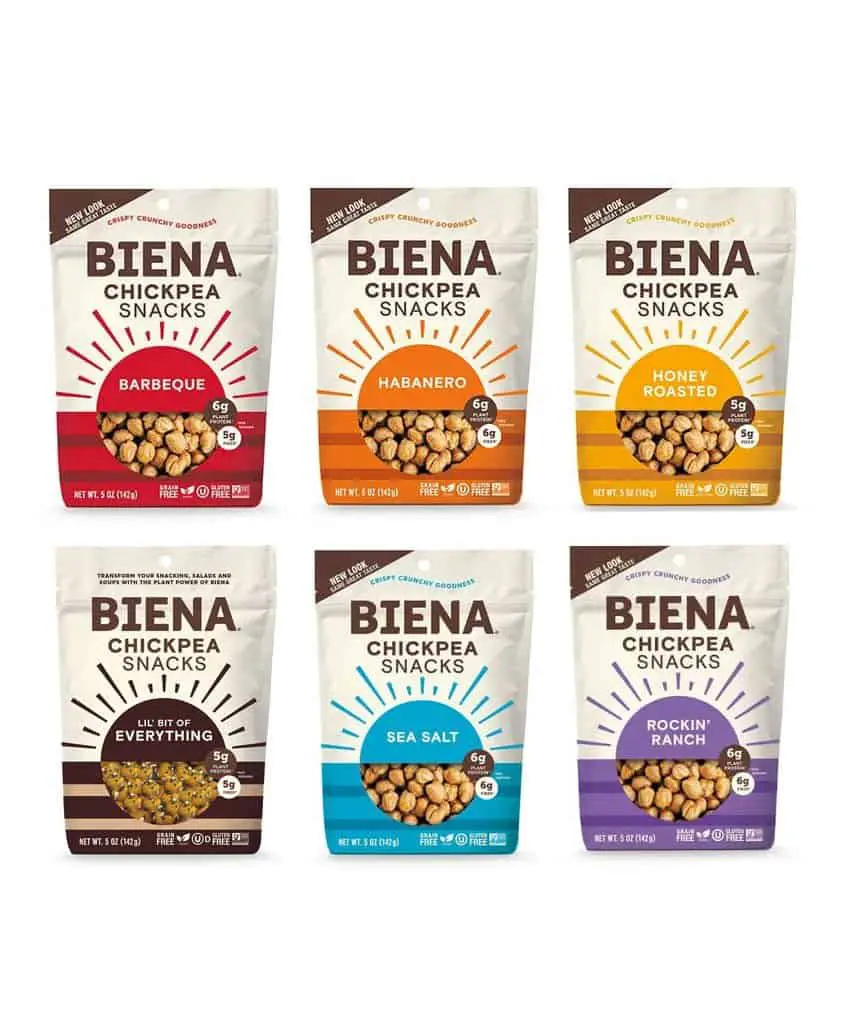
- Seasnax seaweed snacks—This brand makes “strangely addictive” seaweed snacks, as their tagline states. They use 100% olive oil and few other ingredients. Seaweed is high in iodine and other minerals that most of us don’t get enough of. Give them a try here on amazon (I linked you to the lime flavor, but all the varieties are good).
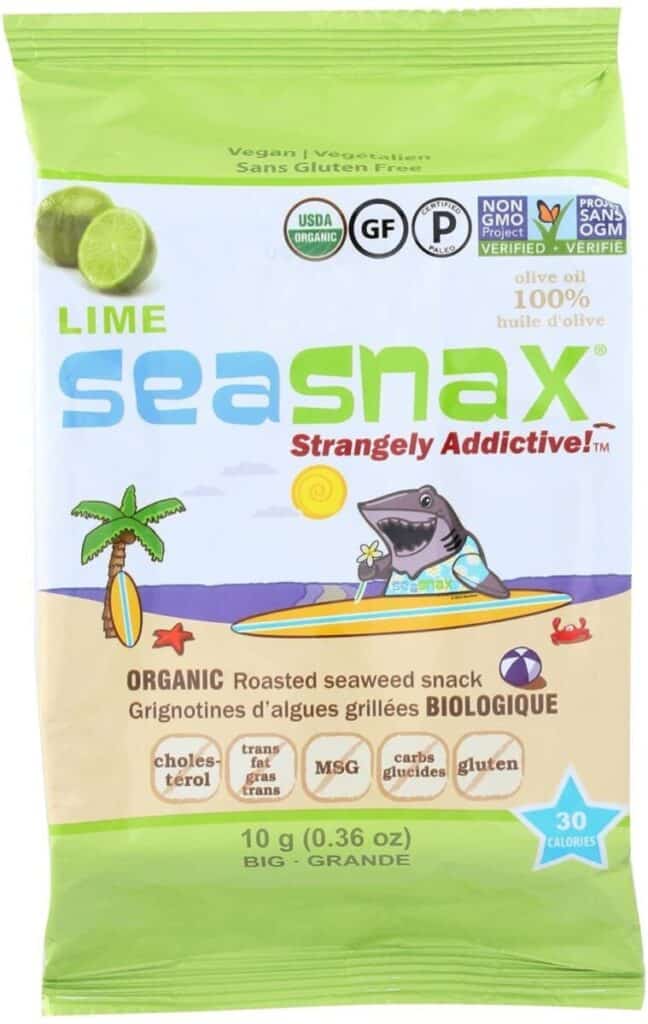
- Dill pickles—Having a dill pickle spear with your sandwich is a great way to get a hit of crunchy, salty flavor. Why eat dill potato chips when you can have a pickle made with real dill? Choose pickles made with brine, not vinegar; the ones with vinegar don’t have probiotics, and don’t taste as good. Try Kruegermann Dill Pickles, available on amazon here (the cloudy liquid is normal).
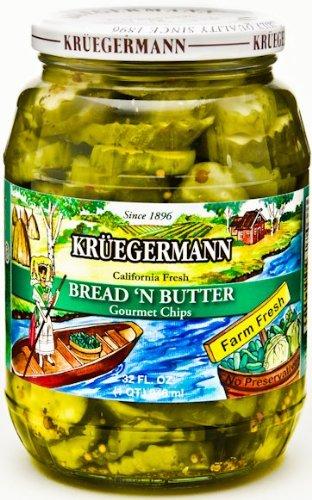
- Plant-based baked snacks—I wouldn’t suggest making these a staple in your diet; they are highly-processed and not dense in nutrients. Still, when you need to satisfy a salty/crunchy craving, these are a much better choice than potato or nacho chips.
- Harvest Snaps are made from peas, black beans or red lentils (these are the primary ingredients of the different varieties) and are baked, not fried. Nevertheless, canola oil is a major ingredient. You can shop for a multi-pack here on amazon (not easy to find in stores).
- Enjoy Life Lentil Chips have lentil flour as their primary ingredient. They are baked not fried, but canola oil is a major ingredient. You can order a variety pack here on amazon (not easy to find in stores).
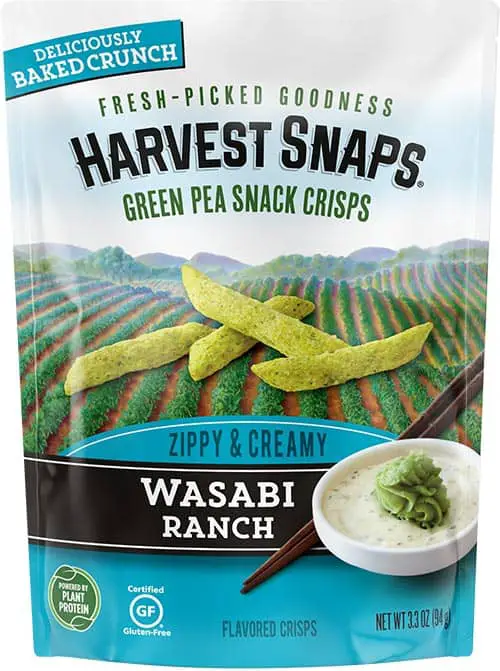
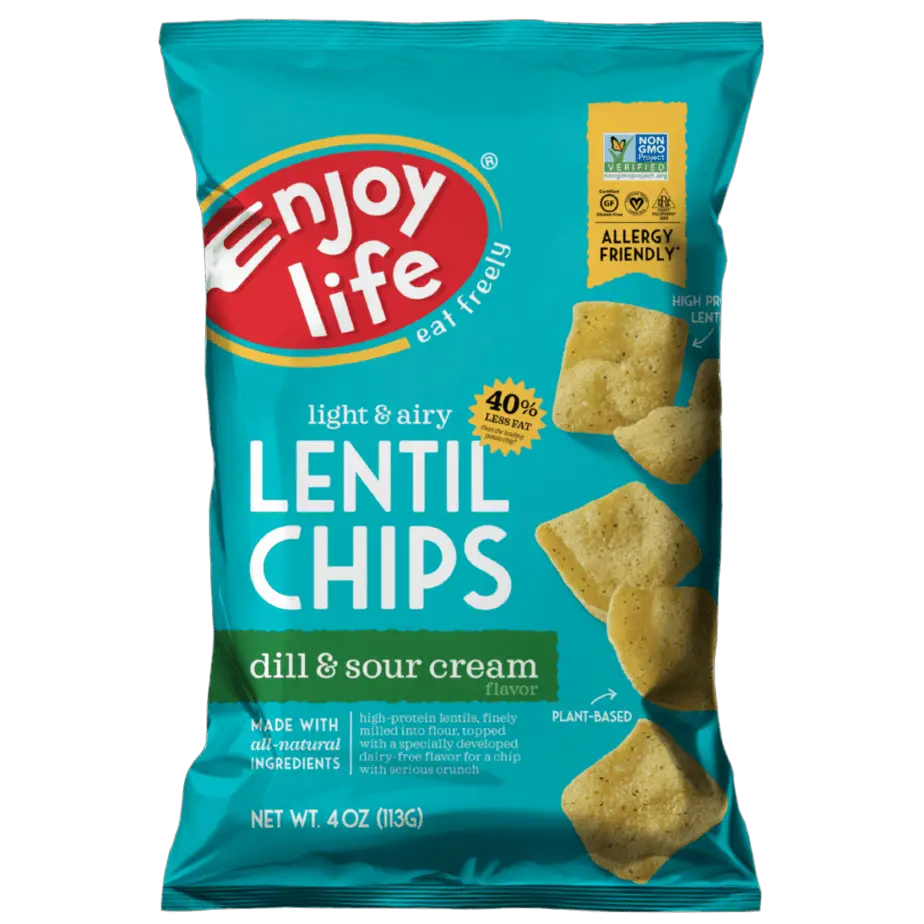
Don’t be fooled by products like Veggie Stix, where the top two ingredients are Potato Starch and Dehydrated Potato, and are fried, not baked (based on the brand’s statement “cooked in expeller-pressed oil.” Isn’t that just another potato chip? Many bagged salty snacks disguise themselves as healthy when they are little better than regular potato chips; be sure to read the labels and look for products that are baked, not fried, for better health
All these choices can satisfy your crunchy, salty cravings. It won’t be long before you don’t miss potato chips at all!
Potato Chip Brand Nutrition Facts: A Comparison Chart
Take a look at this nutrition comparison of the top-selling brands of potato chips, plus two healthy snack foods: an apple and popcorn.
Based on a one-ounce serving, except for the apple
| Brand | Calories | Fat (grams) | Sodium (mg) | Carbs (gram) | Protein (gram) | Fiber | Vitamin C (% DV) | Iron (% DV) |
| Pringles (plain) | 150 | 9 | 150 | 16 | 1 | <1 | N/A | 0.1 |
| Lay’s (plain) | 160 | 10 | 170 | 15 | 2 | 1 | 6 | 2 |
| Lay’s (sour cream and onion) | 160 | 10 | 160 | 15 | 2 | 1 | 10 | 2 |
| Lay’s (baked) | 120 | 3.5 | 160 | 22 | 2 | 1 | N/A | 0 |
| Cape Cod (plain) | 140 | 8 | 125 | 16 | 2 | 1 | 0 | 0 |
| Less Fat Cape Cod (original) | 130 | 6 | 125 | 18 | 2 | 2 | 0 | 2 |
| Ruffles (plain) | 160 | 10 | 150 | 15 | 2 | 1 | 6 | 2 |
| Terra vegetable chips | 150 | 9 | 110 | 16 | 1 | 3 | 0 | 1 |
| Apple (1 medium) | 95 | 0 | 0 | 25 | 0 | 17 | 14 | 1 |
| Popcorn (air-popped) | 110 | 1 | 2 | 22 | 4 | 4 | 0 | 1 |
Chip information based on packaging labels as of Sept., 2021.
Apple and popcorn information: U.S. Department of Agriculture:
- Apple: https://fdc.nal.usda.gov/fdc-app.html#/food-details/786631/nutrients
- Popcorn: https://fdc.nal.usda.gov/fdc-app.html#/food-details/167959/nutrients
Note that the serving sizes are by the ounce, but the single-serving bags are usually bigger than an ounce. For example, the Lay’s lunch-size bag contains 1 ½ ounces. You’re actually getting 240 calories from chips when you have a lunch-size bag of Lay’s.
As you can see, even the baked or low-fat types are not a calorie bargain.
Why Potato Chips are Not Good For You
It’s not just the calories. Here are the other nutritional downsides of chips:
- Low nutritional value—Chips may have a little vitamin C and iron, as the chart above shows, but these nutrients come at a high cost. You would have to eat 368 calories’ worth of Lay’s plain chips to get the same amount of vitamin C that is in one medium apple. You would have to eat 2,720 calories of Lay’s chips to get the same fiber as in one apple.
- High in acrylamide—Fried food has an increased amount of acrylamide. According to the American Cancer Society (https://www.cancer.org/cancer/cancer-causes/acrylamide.html), this substance is formed by sugars and an amino acid that are found naturally in starchy foods. Its concentration is dramatically increased by high heat cooking, like frying, roasting and baking. It is a known toxin and carcinogen. Foods like French fries and potato chips top the list of acrylamide-containing foods.
- High in empty carbs—Potato chips, especially if eaten alone as a snack, will spike your blood sugar, stressing you system and causing an energy crash after you eat them.
- High in salt—Salt blunts the satiation response. You’ll eat more than you really want when chips are doused in salt. And as you already knew, a diet high in salt is linked with high blood pressure and other ill health effects.
- Link to weight gain—A study in the New England Journal of Medicine assessed the effects of lifestyle changes including physical activity, television watching, alcohol use, sleep duration, and diet on weight in 120,877 people over 20 years. The study analyzed the impact of foods including fruits/vegetables, whole grains, refined grains, potatoes, potato chips, dairy products, sugar-sweetened beverages, sweets, processed/unprocessed meats, and fried foods on weight. Of all of the foods and lifestyle habits studied, an increase in potato chip consumption was associated with the highest amount of weight gain!
- Unhealthy fats—Most chips are fried in corn, soybean, canola or cottonseed oils. Many of these fats have a poor omega 3/omega 6 profile, which is inflammatory, and can trigger weight gain and a host of health problems. Frustratingly, most chips ingredient labels list the possible fats in the ingredients, like this, from both the Lay’s (plain) and Ruffles (plain) labels: “Sunflower, corn and/or canola oil.” Which is it? We don’t know; it’s up to the chip manufacturer. Why do they do this? To save money, of course. You can read more about that on a food supplier’s website here: http://www.centrafoods.com/blog/why-its-ideal-to-list-multiple-potential-bulk-oil-ingredients. If the healthier oil is more expensive, you can bet the unhealthier ones will be used.
Why Do We Crave Potato Chips When They Are So Bad For Us?
A few reasons:
- Human beings are hard-wired from our caveman days to prefer high-calorie foods. When food was scarcer than it is today, this instinct helped keep us alive. Today, it helps keep us overweight.
- We are also hard-wired to prefer salt because it is necessary for life, but used to be hard to find in our caveman days. We like the taste and it gives us a dopamine hit to ingest it.
- Crunchy foods instinctively appeal to us as crunch is an indication of freshness. This serves us better when assessing celery than potato chips, but our brains don’t differentiate when it comes to crunch. Research has been done on the appeal of relative degrees of crunch in potato chips, believe it or not (see references). In one food study, the louder the crunch, the more people ate.
- Chips are easy to eat. They are readily available and need no cooking or prep time. They are very convenient when you’re busy or feeling lazy.
But you don’t have to give up savory snacks or having a crunchy side dish with your sandwich. Try the delicious, healthier alternatives in this article, and you’ll learn to love them better than chips; and you can eat them guilt-free.
If you found this article interesting, you might like The Healthiest Breakfast Cereals round-up on my blog.
If you like coffee with your cereal, read this article about 11 Healthy Vegan Mix-ins to level-up your morning joe.
Replace those chips with these 11 High-Energy Foods for Vegans—a quick read.
Thanks for reading!
Resources
- Book: “The Power of Habit,” by Charles Duhigg
- Dieuwerke P Bolhuis, Andrew Costanzo, Lisa P Newman, Russell SJ Keast, Salt Promotes Passive Overconsumption of Dietary Fat in Humans, The Journal of Nutrition, Volume 146, Issue 4, April 2016, Pages 838–845, https://doi.org/10.3945/jn.115.226365.
- Spence, C. Eating with our ears: assessing the importance of the sounds of consumption on our perception and enjoyment of multisensory flavour experiences. Flavour 4, 3 (2015). https://doi.org/10.1186/2044-7248-4-3.
- Adam Drewnowski, M.R.C. Greenwood, Cream and sugar: Human preferences for high-fat foods, Physiology & Behavior, Volume 30, Issue 4, 1983, Pages 629-633, ISSN 0031-9384, https://doi.org/10.1016/0031, 9384(83)90232-9. https://www.sciencedirect.com/science/article/pii/0031938483902329.
- High in acrylamide—Fried food has an increased amount of acrylamide. According to the American Cancer Society (https://www.cancer.org/cancer/cancer-causes/acrylamide.html), this substance is formed by sugars and an amino acid that are found naturally in starchy foods. Its concentration is dramatically increased by high heat cooking, like frying, roasting and baking. It is a known toxin and carcinogen. Foods like French fries and potato chips top the list of acrylamide-containing foods.
- Wang, M., Moran, A. E., Liu, J., Qi, Y., Xie, W., Tzong, K., & Zhao, D. (2015). A Meta-Analysis of Effect of Dietary Salt Restriction on Blood Pressure in Chinese Adults. Global heart, 10(4), 291–299.e6. https://doi.org/10.1016/j.gheart.2014.10.009.
- Mozaffarian D, Hao T, Rimm EB, Willett WC, Hu FB. Changes in diet and lifestyle and long-term weight gain in women and men. N Engl J Med. 2011;364(25):2392–404. https://doi.org/10.1056/NEJMoa1014296.
